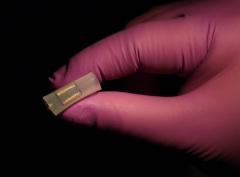
Researchers say the sensor combines accuracy levels approaching that of PCR testing with the speed of rapid antigen tests, and could be used for mass testing at airports, schools, and hospitals
Catherine Graham March 29, 2022
A COVID-19 sensor developed at Johns Hopkins University could revolutionize virus testing by adding accuracy and speed to a process that frustrated many during the pandemic.
In a new study published today in Nano Letters, the researchers describe the sensor, which requires no sample preparation and minimal operator expertise, offering a strong advantage over existing testing methods, especially for population-wide testing.
“The technique is as simple as putting a drop of saliva on our device and getting a negative or a positive result,” said Ishan Barman, an associate professor of mechanical engineering, who along with David Gracias, a professor of chemical and biomolecular engineering, are senior authors of the study. “The key novelty is that this is a label-free technique, which means no additional chemical modifications like molecular labeling or antibody functionalization are required. This means the sensor could eventually be used in wearable devices.”
Barman says the new technology, which is not yet available on the market, addresses the limitations of the two most widely used types of COVID-19 tests: PCR and rapid tests.
PCR tests are highly accurate, but require complicated sample preparation, with results taking hours or even days to process in a laboratory. On the other hand, rapid tests, which look for the existence of antigens, are less successful at detecting early infections and asymptomatic cases and can lead to erroneous results.
Click here to read more via the JHU HUB.
